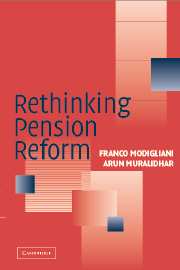Book contents
- Frontmatter
- Contents
- Preface
- Acknowledgments
- A Tribute to Franco
- Rethinking Pension Reform
- 1 A Primer on Pension Reform
- 2 A Taxonomy of Pension Reform Issues
- 3 An Evaluation of Pension Reforms
- 4 Welfare Costs of Defined Contribution Schemes
- 5 The Transition from PAYGO to Funding with a Common Portfolio: Application to the United States
- 6 Social Security Reform in Spain
- 7 The “Two-Pension Fund” Theorem
- 8 The Case for Mixed Systems and Variable Contributions: Improving the Performance of Pension Systems
- References
- Index
4 - Welfare Costs of Defined Contribution Schemes
Published online by Cambridge University Press: 22 August 2009
- Frontmatter
- Contents
- Preface
- Acknowledgments
- A Tribute to Franco
- Rethinking Pension Reform
- 1 A Primer on Pension Reform
- 2 A Taxonomy of Pension Reform Issues
- 3 An Evaluation of Pension Reforms
- 4 Welfare Costs of Defined Contribution Schemes
- 5 The Transition from PAYGO to Funding with a Common Portfolio: Application to the United States
- 6 Social Security Reform in Spain
- 7 The “Two-Pension Fund” Theorem
- 8 The Case for Mixed Systems and Variable Contributions: Improving the Performance of Pension Systems
- References
- Index
Summary
It is evident that countries in the process of reforming their pension systems have leaned toward implementing mandatory, individual account, defined contribution (DC) schemes that are privately managed to partially or entirely replace their PAYGO DB schemes. In the United States, the discussions are increasingly drifting in the same direction with President Bush. The recently appointed Bush Commission on Social Security advocates some version of a privatized Social Security scheme. The chronic problem of mandated DC schemes is that individuals bear the investment risk, and they are the least capable economic unit to do so. Therefore, with variability of investment returns, individuals could retire with an annuity below a basic target level.
Chapter 2, and Muralidhar and Van der Wouden (1998a), recommend an alternative model, which we will refer to as a contributory, funded, defined benefit plan (CFDB). A CFDB plan is a funded scheme whereby the government ensures the benefit through a guaranteed real rate of return on fixed contributions. This scheme has all the attractive properties of a DC scheme while capturing the risk-sharing and insurance benefits of a defined benefit (DB) scheme. In Muralidhar and Van der Wouden (1998a), the authors provide a “gedanken” experiment to demonstrate how a CFDB would bewelfare-improving over the currently implemented DC alternative, with less political risk and better incentives for regulation, when the system is mandatory. That paper provided the structure and institutional requirements for such a model, to protect against a large fraction of the population retiring poor.
- Type
- Chapter
- Information
- Rethinking Pension Reform , pp. 71 - 102Publisher: Cambridge University PressPrint publication year: 2004



